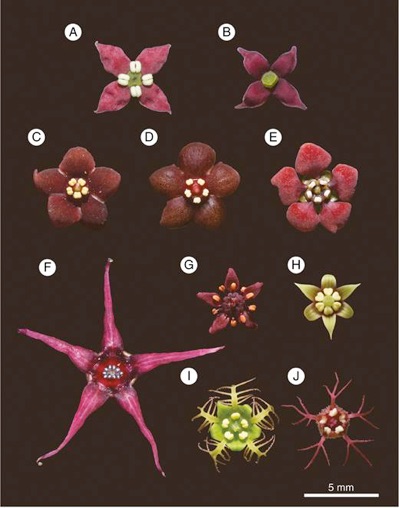RESEARCH
(1) ORIGIN AND EVOLUTION OF OBLIGATE POLLINATION
MUTUALISM IN THE PHYLLANTHEAE–EPICEPHALA
ASSOCIATION

The tribe Phyllantheae is a pantropical group of more than 1200 species in the family Phyllanthaceae and include plants with particularly diverse growth forms, ranging from herbs, shrubs, and trees to rarely climbers, rheophytes, succulents, and aquatics. Approximately half of the species (mostly shrubs and trees) are pollinated by species-specific moths of the genus Epicephala (Gracillariidae) that lay eggs in female flowers and consume the seeds as larvae. Before ovipositing into an ovary, an adult Epicephala female uses her proboscis to actively collect pollen on a male flower and pollinate the female flower to ensure that larval food (seeds) is produced for her offspring. The larva will consume only a subset of the seeds within a fruit, thus there is also a net benefit on the side of the plant.
This type of obligate association between a plant and its seed-parasitic pollinator has been known for long time in the fig–fig wasp and yucca–yucca moth associations. The Phyllantheae–Epicephala association is a recently discovered system and therefore offers a great opportunity for comparative analyses on various aspects of mutualism and coevolutionary process. Currently, I am trying to answer the following questions:
-
What are the pollination systems of plants related to the Epicephala-pollinated species, and how did the mutualism originate from less-specialized systems?
-
What are the life histories of moths related to the pollinating species of Epicephala?
-
Does high plant–moth specificity lead to parallel speciation in the two groups?
-
How and why did plant–moth specificity evolve?
-
Does plant–moth coevolution promote reciprocal diversification?
-
Why do the moths not consume all seeds, and how does the mutualism persist over evolutionary time despite potential for such overexploitation?
(2) DIVERSITY OF POLLINATION SYSTEMS IN ANGIOSPERMS
Much of the present diversity of angiosperm flowers is the result of interaction with animal pollinators. While we are familiar with flowers adapted to bee, bird, or butterfly pollinators, surprisingly large number of plant species (especially those found in the tropics) bear flowers that cannot be categorized into known pollination syndromes. It is important to clarify the pollination systems of plants whose pollinators have not been studied, and to study how the flowers are adapted to such pollinators, in order to fully understand the evolution of floral diversity.
We have recently shown that plants in at least five different families bear strikingly similar, dark red flowers that are pollinated mainly by fungus gnats. These plants grow in the understory or along streams in temperate forests of Japan where fungus gnats are predictably abundant. Flowers with similar floral characteristics are found in many other plant families occurring in many parts of the world, suggesting that plant–fungus gnat interaction may have been largely overlooked.

Fungus gnat-pollinated flowers: (A) Aucuba japonica (male flower; Garryaceae); (B) A. japonica (female flower); (C) Euonymous lanceolatus (Celastraceae); (D) E. melananthus; (E) E. tricarpus; (F) Disanthus cercidifolius (Hamamelidaceae); (G) Micranthes fusca (Saxifragaceae); (H) Streptopus streptopoides (Liliaceae); (I) Mitella koshiensis (Saxifragaceae); (J) M. furusei. Fungus gnat pollination in Mitella has previously been reported by Okuyama and Kato (2004).